Related Research Articles
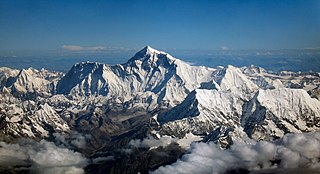
Mount Everest is Earth's highest mountain above sea level, located in the Mahalangur Himal sub-range of the Himalayas. The China–Nepal border runs across its summit point. Its elevation of 8,848.86 m was most recently established in 2020 by the Chinese and Nepali authorities.

Tenzing Norgay, born Namgyal Wangdi, and also referred to as Sherpa Tenzing, was a Nepali-Indian Sherpa mountaineer. He was one of the first two people known to certainly reach the summit of Mount Everest, which he accomplished with Edmund Hillary on 29 May 1953. Time named Norgay one of the 100 most influential people of the 20th century.

Cho Oyu is the sixth-highest mountain in the world at 8,188 metres (26,864 ft) above sea level. Cho Oyu means "Turquoise Goddess" in Tibetan. The mountain is the westernmost major peak of the Khumbu sub-section of the Mahalangur Himalaya 20 km west of Mount Everest. The mountain stands on the China Tibet–Nepal Province No. 1 border.

Kamet is the second-highest mountain in the Garhwal region of Uttarakhand, India, after Nanda Devi. It lies in the Chamoli District of Uttarakhand. Its appearance resembles a giant pyramid topped by a flat summit area with two peaks.

Pasang Lhamu Sherpa was the first Nepalese woman to climb the summit of Mount Everest.

Apa, nicknamed "Super Sherpa", is a Nepalese Sherpa mountaineer who, until 2017, jointly with Phurba Tashi held the record for reaching the summit of Mount Everest more times than any other person. As part of The Eco Everest Expedition 2011, Apa made his 21st Mount Everest summit in May 2011 then retired after a promise to his wife to stop climbing after 21 ascents. He first summited Everest in 1990 and his last time to the summit was in 2011.
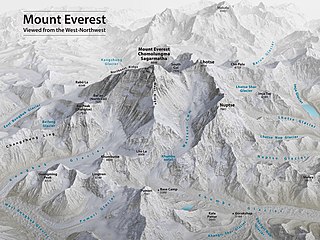
Mount Everest is the world's highest mountain, with a peak at 8,849 metres (29,031.7 ft) above sea level. It is situated in the Himalayan range of Solukhumbu district, Nepal.

The 1996 Mount Everest disaster occurred on 10–11 May 1996 when eight climbers caught in a blizzard died on Mount Everest while attempting to descend from the summit. Over the entire season, 12 people died trying to reach the summit, making it the deadliest season on Mount Everest at the time and the third deadliest after the 22 fatalities resulting from avalanches caused by the April 2015 Nepal earthquake and the 16 fatalities of the 2014 Mount Everest avalanche. The 1996 disaster received widespread publicity and raised questions about the commercialization of Everest.
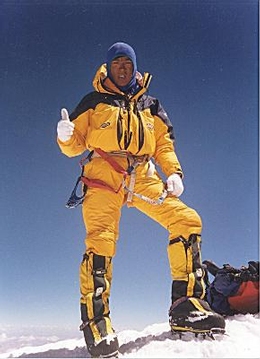
Ang Dorje (Chhuldim) Sherpa is a Nepali sherpa mountaineering guide, climber, and porter from Pangboche, Nepal, who has climbed to the summit of Mount Everest 22 times. He was the climbing Sirdar for Rob Hall's Adventure Consultants expedition to Everest in spring 1996, when a freak storm led to the deaths of eight climbers from several expeditions, considered one of the worst disasters in the history of Everest mountaineering.
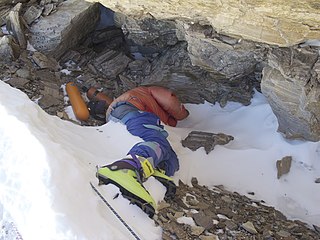
The May 1996 expedition by the Indo-Tibetan Border Police to reach the summit of Mount Everest happened in the background of the 1996 Mount Everest disaster, and resulted in three members of the expedition dying.

Arvind Raturi is the youngest mountaineer from Uttarakhand to scale Mount Everest at the age of 20. As a member of the NCC Mt Everest Expedition 2013, Arvind summited the world’s highest peak on 19 May 2013 at 0730 hours (IST).
Pasang Dawa Lama was a Sherpa Nepalese mountaineer, sirdar. Pasang is considered to be one of the greatest Sherpa mountaineers of the 20th century.
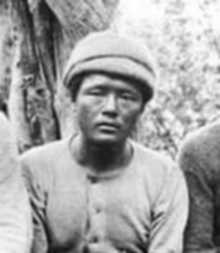
Pasang Kikuli (1911–1939) was a Nepalese mountain climber and explorer who acted as sherpa and later sirdar for many Himalayan expeditions. He died on the 1939 American Karakoram expedition to K2, attempting to rescue a stranded climber.

The 1965 Indian Everest Expedition reached the summit of Mount Everest on 20 May 1965. It was the first successful scaling of the mountain by an Indian climbing expedition.
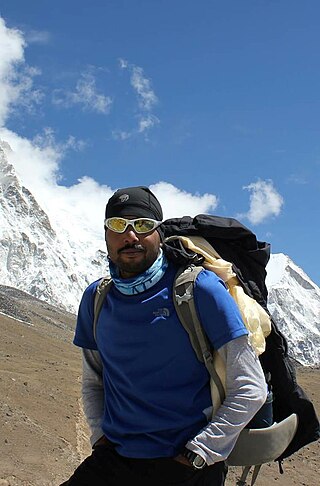
Unnikannan is the first Keralite to successfully climb Mount Everest twice. He is a native of Azhuthan Poyil Veetil from Peringome, a village near to Payyannur in Kannur district of Kerala State, India
References
- 1 2 "Indian Army to launch Everest expedition". IBN. 14 February 2007. Retrieved 20 January 2014.
- 1 2 3 "Indian Army team summits Mt Everest". May 15, 2007. Retrieved 31 December 2013.
- ↑ "Himalayan Expeditions". Himalaya Expeditions. Archived from the original on 10 February 2014. Retrieved 20 January 2014.
- 1 2 Sherpa, Mingmar (2008). Negi, RPS (ed.). My Story: From Kanchhi to the Summit of Everest. Vol. 31. Translated by S Vinod. Fourth Gurkha Rifles Officers Association. pp. 160–63.
- 1 2 3 "Trekking Agencies' Association of Nepal". Trekking Agencies' Association of Nepal (TAAN). Archived from the original on 1 February 2014. Retrieved 20 January 2014.
